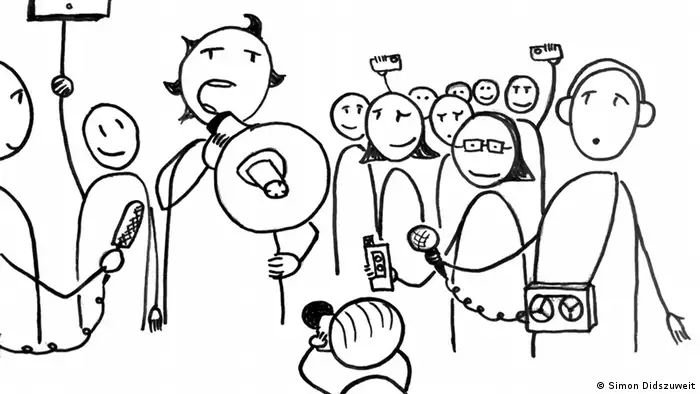Insights
Media for the community, by the community
Community media is getting a lot of attention these days and there are high expectations around it. Many think it can fill gaps in the media landscape and give a voice to the voiceless. Still, it faces many challenges.
Community media is any form of independent and non-profit media, owned and controlled by the community. Operations are seen as participatory, often relying on community volunteers to produce, present and develop their own (news) programs and share information in languages community members understand.
Characteristics
Although there is no single definition for community media, there are at least four characteristics widely agreed on.
- It is independent from governments, donors, advertisers and other institutions.
- It is not-for-profit:any surplus made is reinvested in the station and the community.
- Participation is possible for all community members and at all levels – programming, operating and even financing.
- Community media outlets support and contribute to their community’s social, economic and cultural development.
What is a community, exactly?
There is still no well-defined answer to the question of what exactly constitutes a community.
Usually the community is defined geographically, but its can range from small towns to big cities to vast rural areas. This raises several important questions: Who belongs to the community and is therefore allowed to participate? How can the media organization ensure that everybody interested can participate?
There are also communities of interest, such as women, youth, farmers or linguistic and cultural minority groups. While there is likely common ground in the communities of interest, this cannot be taken for granted in the geographical communities.
Why is community media important?
Community media can contribute to the empowerment of civil society. Community media outlets offer alternative content that may not be available in other media. For example, it may address local concerns and provide information about local cultures that mainstream media overlook or don’t have the resources to cover. It may do this in local languages.
Community media can also allow different groups: access to media policy-making, to select the media information they hear, to produce media and to get direct feedback from the community it serves.
Producing one’s own programs or newscasts, for instance, may help to develop people's ability to critique the productions and methods of established media organizations, as well as provide the opportunity to develop informed opinions. Combined with their activities in media production, a permanent discourse about participation in these stations may provide people involved the knowledge needed to create new kinds of participatory processes.
Despite the benefits, those engaged in community media face many challenges.
They struggle with adverse legal frameworks, non-transparent and corrupt licensing processes, financial problems, and a lack of human resources. In some cases, some involved in community media may also pursue predominately private interests or indirectly support political groups.
Community media and media development
Community media forms an independent media sector, which is separate from and provides an alternative to commercial media, state-run media or public-service media. The idea of participatory communication in community media is to encourage the community to take part in the general public discourse, and also to strengthen an internal democratic process by putting decision-making processes in the hands of community members.
Media development actors today work not only with individual community media outlets, through consultancy and training, for example, but also with community media networks and associations. Here they often support exchange, capacity building and lobbying.
Must reads
“The Concept of Participation. If they have access and interact, do they really participate” by Nico Carpentier (download as pdf)
“Empowering Radio” by Bruce Girard (download as pdf)
“In the Service of the Public” by Jan Lublinski (ed.) (download as pdf)
“The Participative Medium: Radio in the process of democratization” by Esther Dorn-Fellermann (in the book “Radio: The Resilient Medium” by Madalena Oliviera, Grazyna Stachyra and Guy Starkey).
DW recommends
- Date 27.05.2015
- Author Esther Dorn-Fellermann
- Feedback: Send us an e-mail. Please include your name and country in your reply.
- Print Print this page
- Permalink https://p.dw.com/p/1FX2T
- Date 27.05.2015
- Author Esther Dorn-Fellermann
- Send us your feedback.
- Print Print this page
- Permalink https://p.dw.com/p/1FX2T

